Volleyball is a popular sport played by people of all ages around the world. One of the most important aspects of playing volleyball is understanding the court layout and player positions.
Whether you’re a beginner or a seasoned player, knowing the ins and outs of the volleyball court and player positions is crucial to success on the court.
In this article, we will focus on youth volleyball and provide information on the playing court and player positions.
Volleyball Court
The measurements of a volleyball court is 30’ x 60’. Each team’s side of the court is 30’ x 30’. The center line is marked at the center of the court dividing it evenly.
The net is hung directly above the center line. The attack line is 10 feet from the center line.
The end line is a line that is parallel to the net at the back of each playing area.
While serving, players must stay behind this line until contact is made.
The sidelines mark the sides of each playing area.
All players, except the server, must be inside these lines at the time of service. After the serve players may go after balls outside of these lines.
Frontcourt is the area between the attack line and the net on each side of the net.
Backcourt is the area between the attack line and the end line on each side of the net.
Volleyball Player Positions
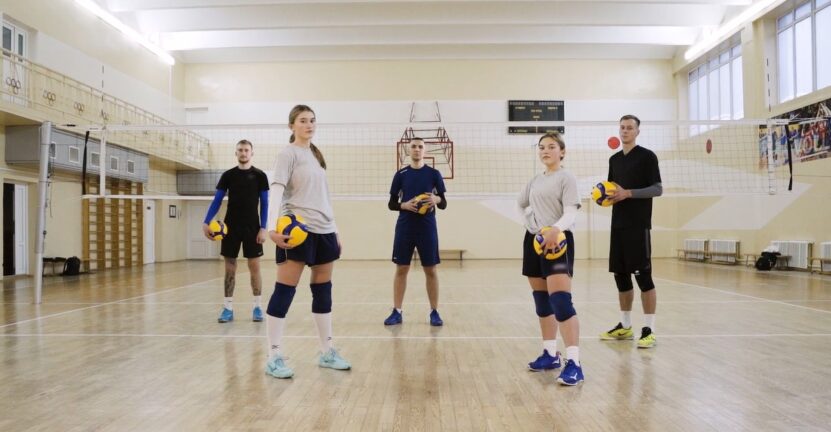
Volleyball is played by two teams of players on a court divided by a net.
At the youth level, volleyball is typically played 3v3 for the 6- to 9-year age group, 4v4 for the 10- to 11-year age group, and 6v6 for the 12 and above age groups.
Each player has a designated starting position. For example, on a six-player court, there are positions 1 to 6, with position 1 being the serving position.
Of the 6 players, 3 are to the front and 3 to the back, with the back player at the left being the server.
Everyone gets to play in every position on the court. Each time your team wins the serve from the other team all your players rotate their position on the court clockwise.
The most common specialization comprises three positions: attacker/blocker (also differentiated in “outside” and “middle”), setter and liberos (defensive specialist).
Setter:
Setters have the task of orchestrating the offense of the team.
They aim for the second touch and their main responsibility is to place the ball in the air where the attackers can hit the ball into the opponent’s court in the easiest way as possible.
Need to be able to break up the opponent’s block.
Typically the most athletic player on the court and must be quick, skillful and accurate. Considered to be the quarterback of the team.
Libero:
A back-row defensive player wearing an opposite-colored jersey that specializes in serve-receive passing, digging, the free ball passing, and setting.
They are usually the players on the court with the quickest reaction time, and the best passing and defensive skills.
Normally the shortest, quickest players on the team. A player designated as a libero for a match may not play other roles during that match.
Middle Blockers:
Middle blockers or Middle hitters are players that can perform very fast attacks that usually take place near the setter.
They act as the teams’ primary blockers and hit from the middle of the court.
In general, they are the tallest players but are often less skillful defensive players.
Outside Hitters:
Outside hitters, also known as power hitters are players that pass, serve, receive, and swing out to hit the ball with an approach coming from the outside of the court.
They are the most skilled players on the court with great ball control and passing abilities.
Outside hitters generally help the libero in receiving the opponent’s serve.
Server:
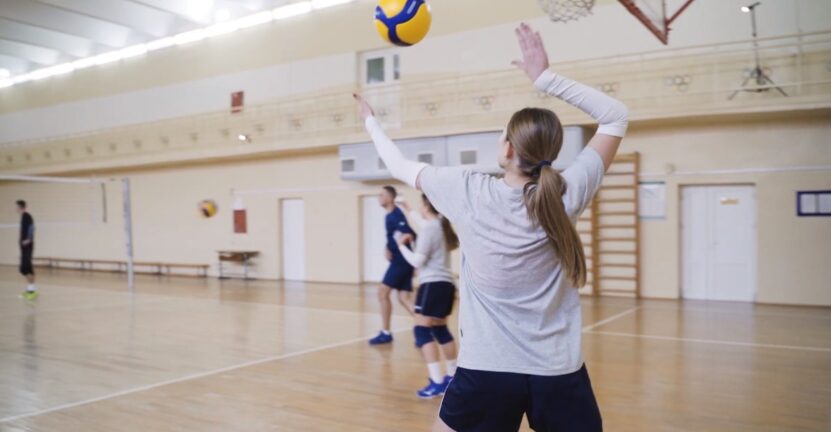
The server is the player on the team that puts the ball into play to start the rally.
The players that understand how to play volleyball the best are often the best servers on the team.
Defensive Specialist
The thing that sets defensive specialist apart from other volleyball positions is their ability to substitute out any player on the court.
This will count against the team’s total of 12 substitutions.
The defensive specialist traditionally focuses on ball control and passing and works well with the libero.
The Rules and Basic Requirements
The game is played by two teams, each consisting of six players, with the primary objective being to score points by hitting a ball over a net and into the opponent’s court without letting it touch the ground. The following are some basic rules and requirements for volleyball:
Court dimensions:
A standard volleyball court measures 18 meters (59 feet) long and 9 meters (29.5 feet) wide. The court is divided into two equal halves by a net, with each team occupying one side. The net height is typically 2.43 meters (7 feet 11 5/8 inches) for men and 2.24 meters (7 feet 4 1/8 inches) for women.
The ball:
Volleyballs are made of leather or synthetic material and are designed specifically for indoor or outdoor play. The ball should have a circumference of 65-67 cm (25.6-26.4 inches) and weigh between 260-280 grams (9.2-9.9 ounces).
Player positions:
Each team has six players on the court, with three players in the front row and three in the back row. The positions are setter, outside hitter, middle blocker, opposite hitter, and libero. The libero is a specialized defensive player who wears a contrasting jersey and can replace any back-row player without counting as a substitution.
Starting the game:
The game begins with a serve, where one team’s player (the server) sends the ball over the net and into the opponent’s court. The opposing team must then return the ball, using a maximum of three contacts, without letting it touch the ground on their side.
Scoring:
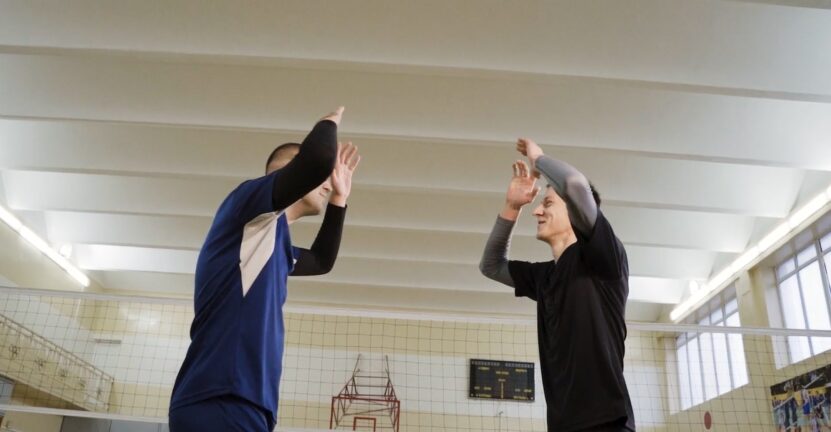
A team scores a point when they successfully land the ball in the opponent’s court, the opponent commits a fault, or the opponent receives a penalty. Teams typically play best-of-five sets, with each set won by the first team to reach 25 points with a minimum two-point lead. If a fifth set is needed, it is played to 15 points with a minimum two-point lead.
Rotation and substitutions:
Players rotate positions clockwise every time they regain the serve. Teams are allowed a maximum of six substitutions per set, with each player limited to three entries per set.
Basic skills:
Volleyball players utilize various skills during the game, such as serving, passing, setting, attacking (spiking), blocking, and digging. Each skill is essential in maintaining control of the ball and helping the team score points.
Faults and violations:
There are several ways a team can commit a fault or violation, including:
-
- The ball touching the ground on their side of the court.
- The ball landing outside the boundary lines.
- A player touching the net or crossing under the net.
- A player making a double contact or lifting the ball.
- A back-row player attacking the ball above the net from within the front zone.
By understanding the basic rules and requirements of volleyball, players can enjoy a fun, competitive, and engaging team sport that promotes physical fitness, teamwork, and strategy.
Terminologies
| Word | Meaning |
|---|---|
| ACE | A serve that scores a point without the receiving team being able to return the serve over the net. |
| BUMP | A pass is used to set an attack. |
| CARRY | Holding a ball for too long will result in this fault. |
| CROSS | This is a type of play in which the middle attacker takes the initiative of attacking as well as defending. |
| CUT | Shot from an impossible angle. |
| DIG | When the first hit is picked up as a first pass. |
| DOUBLE CONTACT | When a player hits the ball two times in a row. |
| DUMP | When a player crosses the ball over the net on a second contact. |
| FIVE ONE | A type of formation |
| FLOATER | A type of service where the volleyball is hit with no spin and less power and seems like it is floating in the air. |
| FOUR TWO | A type of formation |
| JUMP SERVE | A type of service where the server tosses the ball into the air and then jumps up and hits the serve as the ball is coming down. |
| KILL | An attack that results in a successful spike. |
| MISHIT | Untimed hit. |
| PANCAKE | A type of dig when the player uses the backhand flat to the ground allowing the ball to bounce off their hand for the hit. |
| SIDE OUT | A loss in the point causing a change in serve. |
| SIX TWO | A six-player offense where there are two setters in the back row. |
| SPIKE | A type of attack where the ball is served over the net with good force and speed. |
| STRONGSIDE | The court’s left side. Since most of the players are right-handed. |
| TIP | A soft hit attack is used to get the ball over the net quickly. |
| WEAKSIDE | The court’s right side. Since the majority of the players are right-handed. |
| WIPE | When one player pushes the volleyball off the opponent’s block to score winning the point. |
Some Interesting & Fun Facts
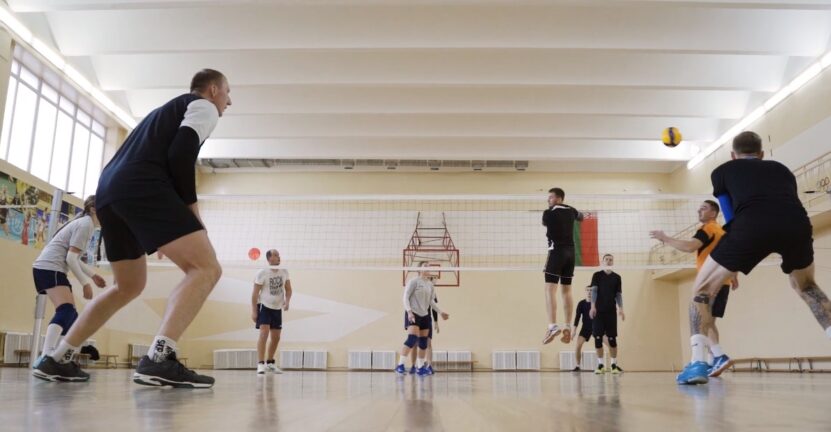
Volleyball is a globally popular sport enjoyed by both men and women. It is also a common school sport, as it challenges players physically and mentally. Here are some intriguing facts about volleyball.
- Volleyball was invented in 1895 by William G. Morgan, who created a new game called Mintonette, incorporating elements of tennis, basketball, handball, and baseball. As players primarily used volleys to score points while moving the ball back and forth, the game quickly became known as volleyball.
- The first official volleyball game was played at Springfield College in Massachusetts on July 7th, 1896.
- The first 2-man beach volleyball game took place in 1930.
- The inaugural Volleyball World Championships were held for men in 1949 and for women in 1952.
- Volleyball made its Olympic debut in 1964.
- The first ball specifically designed for volleyball was created in 1900.
- In a typical volleyball match, most players jump around 300 times.
- The longest recorded volleyball game was played in Kingston, North Carolina, lasting 75 hours and 30 minutes.
- Volleyball is currently the second most popular sport worldwide, surpassed only by soccer.
- A volleyball game is played by two teams, each with six players.
- Though there are numerous volleyball rules and regulations, the basic rules dictate that players must prevent the ball from touching the ground on their own court, with each player allowed to touch the ball only three times and each touch by a different player.
- Faults include double hits by a single player, four consecutive hits at the same time, touching the net while playing, catching and then throwing the ball, and a foot crossing the boundary line while playing.
- Beach volleyball is a more stylish version of the court game and is usually played by three or four players on each side. Beach volleyball became an Olympic sport in 1996 for both men and women.
- The spike and set skills were first introduced during a match in the Philippines in 1916.
- Volleyball was an unofficial sport at the 1924 Paris Olympics.
- The FIVB (Fédération Internationale de Volleyball) was founded in 1947, making volleyball an official sport.
- The first professional beach volleyball tournament took place at Will Rogers State Beach in the summer of 1976, known as the “Olympia World Championship of Beach Volleyball.”
- Volleyball is highly popular among people of all ages because it is an excellent form of exercise.
- Over 800 million people worldwide and 46 million people in the United States play volleyball every week.
FAQ
How is volleyball scored?
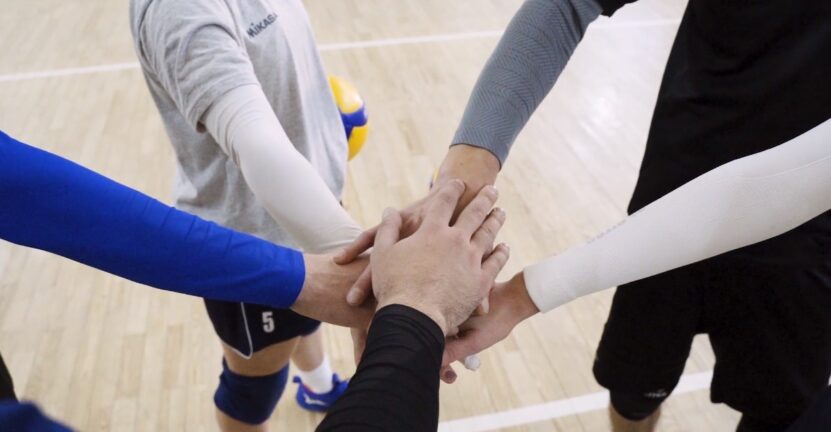
Volleyball is scored by awarding a point to the team that wins each rally.
A rally is won when a team successfully lands the ball in the opponent’s court, the opponent commits a fault, or the opponent receives a penalty.
Sets are won by the first team to reach 25 points with a minimum two-point lead, and if a fifth set is needed, it is played to 15 points with a minimum two-point lead.
What is the libero position in volleyball?
The libero is a specialized defensive player who wears a contrasting jersey and can replace any back-row player without counting as a substitution. They are primarily responsible for serve-receive passing, digging, and free ball passing, and are usually the players on the court with the quickest reaction time and the best passing and defensive skills.
How many players are on a volleyball team?
Each team consists of six players on the court at a time, with three players in the front row and three in the back row. The positions are setter, outside hitter, middle blocker, opposite hitter, and libero.
What is a bump in volleyball?
A bump, also known as a pass, is a technique used to set up an attack.
It involves using the forearms to pass the ball to a teammate, typically the setter, who will then set up an attack.
How high is a volleyball net?
The net height for men is typically 2.43 meters (7 feet 11 5/8 inches) and for women is 2.24 meters (7 feet 4 1/8 inches).
What are some common faults and violations in volleyball?
Some common faults and violations in volleyball include the ball touching the ground on their side of the court, the ball landing outside the boundary lines, a player touching the net or crossing under the net, a player making a double contact or lifting the ball, and a back-row player attacking the ball above the net from within the front zone.
How does the rotation and substitution process work in volleyball?
In volleyball, players rotate positions clockwise every time they regain the serve.
Teams are allowed a maximum of six substitutions per set, with each player limited to three entries per set.
A substitution is counted each time a player enters or exits the game, and the same player can enter and exit multiple times.
The libero can replace any back-row player without counting as a substitution.
How has the sport of volleyball evolved since its inception in the late 19th century?
Since its inception in the late 19th century, the sport of volleyball has evolved in several ways.
The rules have been refined and standardized, with the introduction of specific player positions and substitutions.
Technology has also played a role in the evolution of the sport, with advancements in equipment and training techniques.
Volleyball has become a popular and widely-played sport around the world, with professional leagues and international competitions.
The introduction of beach volleyball as an Olympic sport in 1996 has also contributed to the growth and popularity of the sport.
Conclusion:
Volleyball is a popular sport played by millions worldwide. It involves two teams of six players on a court divided by a net, with the objective of scoring points by hitting a ball over the net and into the opponent’s court without letting it touch the ground.
Understanding the court layout, player positions, and basic rules is essential to enjoying and excelling at the game.

